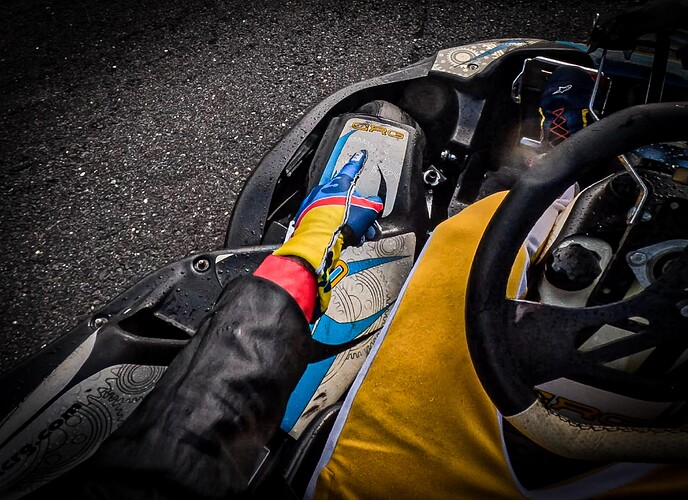Still learning kart setup and want to know some way’s to remove grip. If the kart jacks or hops to much and you want it to drive more stable through the corners. What are some options on setup changes I would have. Want to get some input for my next time I go to OVRP.
Just remember that the tire is what provides grip. Chassis adjustments don’t change that ultimate grip level available. All they do is change how you use that grip.
What you’re looking to do is remove weight jacking generally. Because the more rubber or grip on the track or the softer the tire, the more force going through the frame and causing it to twist and flex.
The general ways to reduce that weight jacking are:
- narrower front track width (reduces weight jacking)
- wider rear track (lowers the relative CoG and reduces rate of inside rear wheel lift
- removing caster (reduces weight jacking)
- lower seat (reduces weight transfer)
- lower rear ride height (reduces weight transfer)
- soften or remove from torsion bar (reduces weight transfer)
Axle changes will depend on what chassis you’re on. Some karts like softer and some like stiffer to reduce rear lift.
I have a 51 min general tuning guide on YouTube that breaks most things down:
Quick question, if Chris is dealing with too much grip, and is dealing with hopping, wouldn’t it make sense to decrease rear track width to promote inside wheel lift?
A kart generally hops when you are on a grippy track and the setup is overloading the outside rear tire, so it sticks, slips, sticks, slips and repeats. If you are overloading the outside rear tire, you are already transferring too much weight onto that tire. A narrow rear track helps the kart ‘tip’ and lift the inside rear wheel. It’s like raising the center of gravity in the rear of the kart relatively. We want to widen the rear track for hopping to help slow that rear lift action down to keep the outside rear tire from going over its limit and slipping, inducing hop.
As a fellow add-50#-plus for ballast, do you ever lower the position of your ballast to reduce hopping?
I might of missed it in the video but didn’t see anything about the toe on a kart. Could that also effect weight jacking on turn in. Also could you give me a refresher on when opening or closing the toe does. Opening just makes it turn in quicker and closing stabilizes turn in, am I missing anything?
You got it. Toe out is going to help turn-in. Toe-in is basically never used in our style of karting. It scrubs on the straight and numbs the front end during turning.
That makes sense, thanks!
TJ, would increase the rear tire pressure a bit also help?
I reason that the tire will deflect much less and load the chassis less. Much less slip, stick, slip, stick…
Yes, but you also risk overheating the tire or altering how the tire performs throughout the run if you start doing that.
In my opinion, tire pressure tuning is a separate thing to chassis tuning, because the tire needs to operate in a specific temperature window and if you’re using it to adjust the “spring rate” of the kart, you are also affecting it’s operating temperature window. If the kart is hopping, there is an inherent balance issue with the kart itself that needs to be sorted before you start altering how your tire is working.
In general, when I’m tuning a kart I am trying to start with the adjustments that have the least amount of knock-on effects to the rest of the chassis. It makes it simpler that way. If I need the kart to turn in quicker, a simple track width adjustment is the first go-to. Not a ton of knock-on effects from changing track widths.
Small tire pressure adjustments to change the kart’s balance are not a bad thing, just be aware you are also affecting the how the kart comes in or goes away during a run, which may be an issue.

